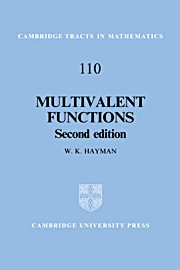Book contents
- Frontmatter
- Contents
- Preface
- Preface to the second edition
- 1 Elementary bounds for univalent functions
- 2 The growth of finitely mean valent functions
- 3 Means and coefficients
- 4 Symmetrization
- 5 Circumferentially mean p–valent functions
- 6 Differences of successive coefficients
- 7 The Löwner theory
- 8 De Branges' Theorem
- Bibliography
- Index
Preface
Published online by Cambridge University Press: 24 November 2009
- Frontmatter
- Contents
- Preface
- Preface to the second edition
- 1 Elementary bounds for univalent functions
- 2 The growth of finitely mean valent functions
- 3 Means and coefficients
- 4 Symmetrization
- 5 Circumferentially mean p–valent functions
- 6 Differences of successive coefficients
- 7 The Löwner theory
- 8 De Branges' Theorem
- Bibliography
- Index
Summary
Suppose that we are given a function f(z) regular in the unit circle, and that the equation f(z) = w has there
(a) never more than one solution;
(b) never more than p solutions; or
(c) at most p solutions in some average sense,
as w moves over the open plane. Then f(z) is respectively univalent, p–valent or mean p–valent in |z| < 1.
It is the aim of this book to study what we can say about the growth of such functions f(z) and, in particular, to obtain bounds for the modulus and coefficients of f(z) and related quantities. Thus our aim is entirely quantitative in character.
The univalent functions represent the classical case of this theory, and we shall study them in Chapters 1, 7 and 8. By and large the methods of these chapters do not generalize to p–valent or mean p–valent functions. The latter two are studied in Chapters 2, 3, 5 and 6. The theory of symmetrization is developed in Chapter 4, both for its applications to Chapter 5 and for its intrinsic interest. This chapter could reasonably be read by itself. Chapter 7 could be read immediately after Chapter 1 by the student interested mainly in univalent functions. Otherwise the chapters depend on preceding work.
The majority of the material here collected has not, to my knowledge, appeared in book form before, and some of it is quite new.
- Type
- Chapter
- Information
- Multivalent Functions , pp. ix - xPublisher: Cambridge University PressPrint publication year: 1994



